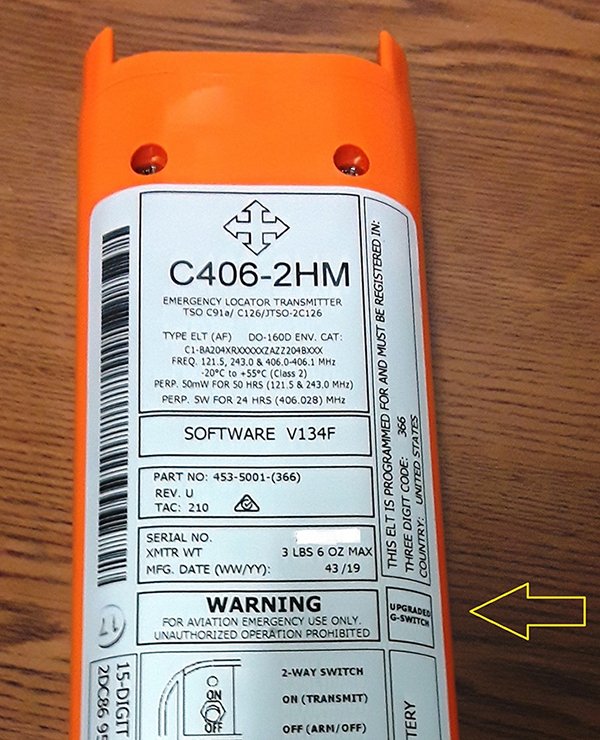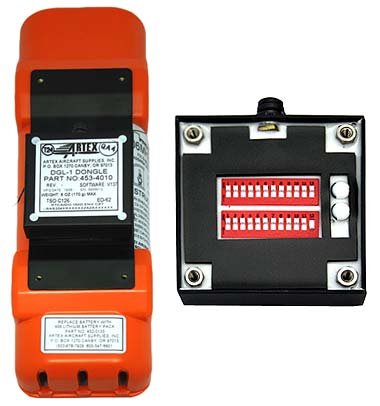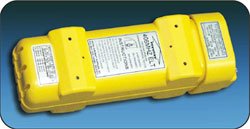Part #:
Model: G406-4
NSN: |
|
OEM: |
ACR/Artex |
Desc: |
ELT w/ 110-324 and 110-329 Whip Antenna |
 Select part number above to view pricing and availability.
Select part number above to view pricing and availability.
| Price | Condition | Status | More Info | |
|---|---|---|---|---|
| $4,965.00 | NEW OUTRIGHT | REQUEST LEAD TIME |
|
| Price | Condition | Status | More Info | |
|---|---|---|---|---|
| REQUEST | NEW OUTRIGHT | REQUEST LEAD TIME |
|
| Price | Condition | Status | More Info | |
|---|---|---|---|---|
| REQUEST | NEW OUTRIGHT | REQUEST LEAD TIME |
|
| Price | Condition | Status | More Info | |
|---|---|---|---|---|
| $5,860.00 | NEW OUTRIGHT | REQUEST LEAD TIME |
|

G406-4
- Transmits on all 3 emergency frequencies
- Automatically activates during a crash and transmits the standard swept tone on 121.5 & 243.0 MHz
- Transmits a 406.025 MHz encoded digital message to the Cospas/Sarsat satellite system
- Tested to meet the TSO C126 requirements as well as 500 G shock, 1000 pound crush & flame and vibration tests
- Available for use with Artex's whip antennas or fiberglass rod antenna
- May be interfaced with the Artex ELT/NAV which enables latitude & longitude data to be transmitted
In order to ship hazardous materials (HAZMAT) the shipper must have HAZMAT certified personnel. SEA will provide HAZMAT paperwork along with proper packaging and labeling for shipments directly to our customers. If the shipment must be sent to another location such as a freight forwarder, SEA will provide the HAZMAT paperwork to the original ship to address only. Please contact your freight forwarder prior to ordering to verify that they are HAZMAT certified. SEA is not responsible for issues that arise if your freight forwarder does not have HAZMAT qualified personnel.
| Dimensions: | 11.74"L x 3.90"H x 3.82"W | Weight: | 3lb 5.8oz |
| Operating Frequencies: | 406.025MHz +/- 2kHz Biphase L 121.5 & 243.0MHz +/- 0.005% | Output Power: | 406MHz: 5 W +/- 2dB for 24hrs @ -20C 121.5/243.0MHz: 100mW min |
| Activation: | Automatic by 4.5ft/sec G-Switch or Manual | Battery: | 5yr Lithium |
| Temperature: | Operating: -20C to +55C Storage: -55C to +85C | Remote Control: | On/Off/Reset |
| Antenna: | Rod (110-320) (<350KTS) Whip Antenna Configuration requires use of 2 antennas: Whip (110-324) (121.5/243Mhz Whip (110-329) (406MHz<250KTS) |
| Part Number | G406-4 ELT Description: |
|---|---|
| 453-5012 | Transmitter Only (Main Assembly) |
| 455-5018* | ELT Base Pack List - contains transmitter & mounting hardware |
| 455-5019* | Complete ELT System with Rod Antenna (110-320) |
| 455-5044* | Complete ELT System with 2 Whip Antennas (110-324 w/inductor & 110-329) |
* Please Note that the Attached "Pack Lists" are for REFERENCE ONLY & are subject to change.
| Price | Condition | Status |
|---|---|---|
| $4,965.00 | NEW OUTRIGHT | REQUEST LEAD TIME |
| Price | Condition | Status |
|---|---|---|
| REQUEST | NEW OUTRIGHT | REQUEST LEAD TIME |
| Price | Condition | Status |
|---|---|---|
| REQUEST | NEW OUTRIGHT | REQUEST LEAD TIME |
| Price | Condition | Status |
|---|---|---|
| $5,860.00 | NEW OUTRIGHT | REQUEST LEAD TIME |
Click on a question below to see the answer. If you have a question about this model that is not answered below, please contact questions@seaerospace.com
In relation to ELTs, what is the difference between short messaging and long messaging?
Long messaging transmits longtitude and latitude. Short messaging does not.
Why do some parts indicate "REQUEST" or “RFQ” on the Southeast Aerospace website?
In relation to NE (New) parts, many OEMs change their prices and availability without any notice to dealers or the industry. Therefore, through the REQUEST or RFQ indication, we ask that customers contact us for the most accurate price and availability.
In relation to SV & OH parts, the used parts aftermarket in the aviation industry is not an infinite supply. It is a dynamic, constantly changing market that is significantly affected by and susceptible to highs and lows in supply and demand. Therefore, although we attempt to, at times, we are unable to predict the exact moment when an item may be available. Once again, through the REQUEST or RFQ indication on our website, we ask that customers contact us for the most current and accurate price and availability.
How is SB1000 indicated on new production ACR/Artex ELTs?
The only indication that new ACR/Artex ELTs have the upgraded G-switch as detailed in SB1000 is the "UPGRADED G-SWITCH" box on the identification plate. Please see image for reference.

What are the requirements for ELT installations?
Starting January 1, 2004 an approved ELT must be installed. An ELT meeting TSO-C91 installed prior to June 21, 1995 is acceptable. An ELT installed after June 21, 1995 must meet TSO-C91a or TSO-C126.
No person may take off an airplane for flight over water more than 30 minutes flying time or 100 nautical miles from the nearest shore, whichever is less, unless it has on board the following survival equipment:
- A life preserver, equipped with an approved survivor locator light, for each occupant of the airplane.
- Enough liferafts (each equipped with an approved survival locator light) of a rated capacity and buoyancy to accommodate the occupants of the airplane.
- At least one pyrotechnic signaling device for each liferaft.
- One self-buoyant, water-resistant, portable emergency radio signaling device that is capable of transmission on the appropriate emergency frequency or frequencies and not dependent upon the airplane power supply (FAR Part 91.509 [b]).
- A lifeline stored in accordance with Sec. 25.1411(g) of this chapter.
What is the meaning and purpose of the Artex ELT ending in part number -999?
Most Artex ELT systems are received by distributors programmed with the ELT serial number for use in the USA. Thus the P/N ends in -366. If the ELT is programmed for another country, then the appropriate labels are placed on the ELT. However, the original dataplate part number remains the same. Dealer/distributors who are authorized to program Artex ELTs are not permitted to change the part number of the ELT.
Therefore, if someone requires an Artex ELT to actually have the -999 part number then this must be requested before the distributor places the order with the factory. Otherwise, programmed ELTs can be programmed with a default hex address and ID to be equivalent to the -999 status. When this is done by an authorized programming facility, the dataplate remains the same but the separate label with country and three digit code becomes blank and the hex ID label indicates the default hex ID.
What is the service life for most ELT 406 MHz?
How does the Artex Programming Dongle (DGL-1) function?
A few other notes regarding the DGL-1:
- The connector between the DGL-1 and ELT is only compatible with the C406 and G406 series ELTs.
- The DGL-1 switches do not have to be set by an approved Artex programming facility.
- The 24 bit address programmed via the DGL-1 switches overwrites any other programming on an ELT once it is powered on.

Why should you install a 406 MHz ELT in place of an existing 121/243 MHz ELT?
While 121.5 MHz is the international distress signal, it has limitations in relation to the search and rescue efforts that would follow the activation of this frequency by an ELT. Accuracy to a crash site of an aircraft with a 121 MHz ELT can be up to 20 miles. With the enhanced performance of the 406 MHz ELT and programmed aircraft information, accuracy is improved to 2 miles.
After February 2009, the 121/243 distress signals will only be detected by ground based receivers such as air traffic control, local airports, or other aircraft. Therefore, the search and rescue efforts related to an aircraft with an older ELT could be limited and will take longer, especially in a remote location.
Some aircraft owners do not respond positively towards FAA mandates. The February 1st 2009 ELT date is not a deadline to comply with any sort of ELT mandate. As mentioned, this date only applies the discontinuance of 121/243 ELT monitoring by the COSPAS-SARSAT satellite system. Therefore, aircraft owners must decide what value to place on their safety and survival should they be put in an emergency situation where the ELT would be activated.
Is an STC required to install an ELT into an aircraft?
Why does my 406 MHz ELT need to be programmed?
An Emergency Locator Transmitter (ELT) should be programmed with either the aircraft tail #, a serial #, or the aircraft operator designator. The aircraft information programmed is determined by your country's requirements. The information is sent to the government agency responsible for keeping the database of the country in which your aircraft is registered.
The ID is linked to your SAR database, containing valuable aircraft information: Type of Aircraft, Address of Owner, Telephone # of Owner, Aircraft Registration #, and Alternate Emergency Contact, etc.
Keeping this information up to date & accurate is a major concern of the Search & Rescue Centers. Without accurate information, valuable time may be lost in attempting to locate the owner of the aircraft.
Your ELT can easily be programmed by a certified repair station, such as Southeast Aerospace.
Contact Southeast Aerospace today for more information on ELT programming.
I am looking for an Artex 406 MHz ELT with a Part Number that ends in -366, can I use another Part Number instead?
Therefore, if you are searching for an Artex 406 ELT ending in the -366 such as 455-5015-[366], then you can use the base number (ex. 455-5015) in most cases.
What does COSPAS mean?
 . These Russian words translate to "Space System for the Search of Vessels in Distress".
. These Russian words translate to "Space System for the Search of Vessels in Distress".
What does SARSAT mean?
Which ELT is most appropriate for my aircraft?
What are the ELT and ELT battery shipping guidelines?
What is the battery life for my Artex ELT?
- After use in an emergency
- After an inadvertent activation of unknown duration
- When the total of all known transmission exceed 1 hour
- On or before the battery replacement data as indicated on the battery label
If any of these conditions are met, the battery must be replaced.
Artex batteries contain a microchip that records total activation time and number of activation times. The ELT tester will show this information when the unit is tested.


